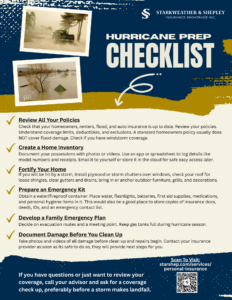
Hurricane Season is Coming!
Every year, homeowners and residents of coastal regions throughout the United States face the potential risk of hurricanes. And whether these seasonal storms prove to be no more than a nuisance or a massively destructive event, is out of their control. What is in their control, however, is how prepared they are.
At Starkweather & Shepley, our risk exposure specialists can help. Here are a few of the tips, pain points, and preventive steps you can take to be in the best position to weather the storm.
Click to see our Hurricane Prep Checklist.
Check that your homeowners, renters, flood, and auto insurance is up to date. Review your policies. Understand coverage limits, deductibles, and exclusions. A standard homeowners policy usually does NOT cover flood damage. Check if you have windstorm coverage. Document your possessions with photos or videos. Use an app or spreadsheet to log details like model numbers and receipts. Email it to yourself or store it in the cloud for safe easy access later. If you will be hit by a storm, install plywood or storm shutters over windows, check your roof for loose shingles, clear gutters and drains, bring in or anchor outdoor furniture, grills, and decorations.1. Review Your Insurance Policy
2. Create a Home Inventory
3. Fortify Your Home and Yard
4. Prepare an Emergency Kit
Obtain a water/fireproof container. Place water, flashlights, batteries, first aid supplies, medications, and personal hygiene items in it. This would also be a good place to store copies of insurance docs, deeds, IDs, and an emergency contact list.
5. Develop a Family Emergency Plan
Decide on evacuation routes and a meeting point. Keep gas tanks full during hurricane season.
6. Document Damage Before You Clean Up
Take photos and videos of all damage before clean up and repairs begin. Contact your insurance provider as soon as its safe to do so, they will provide next steps for you.
Still, have questions? Speak to one of our specialists today and together, we can weather the storm.
Related posts

Hanover Theater Group Photo


